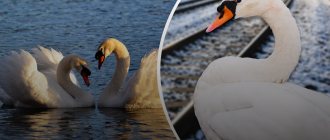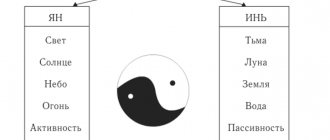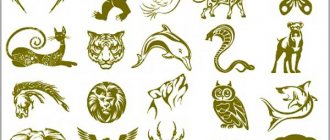The best Feng Shui symbol for attracting love, romantic relationships in life and a symbol of fidelity are swans. A figurine of a pair of swans, symbolizing eternal love, can be made from different materials: porcelain, glass, crystal, various metals, threads. Typically, these two regal birds, white or gold in color, look at each other, as if frozen, admiring their other half.
If we remember our distant childhood, our grandmothers always had on their dresser or shelf such a seemingly modest figurine, symbolizing love. Nowadays there is a wide assortment of various figurines and paintings on sale; you can choose any one to suit your taste, color and size, which can become an amulet for its owner.
Feng Shui approves of any material from which Swans figurines are made
This small amulet is made from completely different and even unexpected materials:
- The most elegant figurines are made of white porcelain. White color represents purity of relationships and tenderness. This figurine is good to give to newlyweds for a wedding.
- A talisman made of rock crystal or glass transforms negative energies into favorable and happy ones. It is good to place a figurine with such swans in the zone of Marriage and Love, in the southwestern part of the bedroom.
- A crocheted figurine of a couple in love looks elegant and homely. Such handmade work will decorate a chest of drawers in a house where the Provence or Country style is maintained.
Positive or negative - depends on the color
Swans have always been a little more fabulous than other birds. If they turned into people, then exclusively into young beauties with magical abilities. If a bird touched a sick person with its wing, it healed him of any ailment. She fearlessly accepted food from a person’s hands and proved his virtue to the whole world. In the Scandinavian countries there is still a legend according to which heaven and earth are two halves of a cracked swan egg.
The vast majority of swan signs are positive, but even among them you can find exceptions.
Signs about white swans
- The white swan on the nest is a kind hostess. To meet one like this is a lifetime of grief.
- A bird with chicks is a symbol of successful childbirth, pleasant family chores. A very important sign for women dreaming of a baby and for pregnant women.
- A single person happened to see a pair of white swans in the sky - the sign advises you to mentally ask for love and a reliable life partner.
Signs about the black swan
With dark birds everything is not so clear. The sign calls the black swan a witch's servant. It is in this form that “collectors of souls” come to the bloody battlefields. In general, it is advisable to stay away from handsome guys with anthracite wings, so as not to invite trouble ahead of time. During the Middle Ages they even tried to exterminate them.
To be fair, it must be said that a negative attitude towards a black swan does not exist everywhere. In Australia, this bird is considered one of the main state symbols and is depicted on coats of arms, flags and postage stamps.
In Europe, noble birds were served at the table of kings and other noble gentlemen. The dish was considered obligatory when a dinner was held in honor of some important guest. And if during the “banquet” a roasted swan did not appear in the refectory, the visitors received a clear hint - the owners were not happy with them!
They are like a miracle - gentle and honest to each other
The swan is a symbol of absolute purity, mercy, peace, rebirth, nobility. Free people who dream of starting a family are recommended to place such an amulet in the northwestern zone of the house to attract a soul mate into their lives. A figurine of a pair of swans is a good gift to give to married couples and newlyweds.
Married couples, having performed this good ritual, will restore harmony in the house, attract romance into the relationship, and renew feelings. This talisman personifies fidelity, impeccability in feelings between a man and a woman. It also happens that if one of the spouses is not very confident in the future fidelity of the chosen one, then you can hang a picture of swans, and be sure to inform your betrothed about this. A talisman of three swans, a couple with a child, will definitely attract the arrival of a child into the house.
The swan amulet is better activated with the help of the Lotus talisman. To attract all the necessary energies, Feng Shui experts advise choosing and clearing a small space in the northwestern zone of the room, or in the far right corner, placing a figurine of swans there, and lighting a red candle nearby.
An image of a swan, as a talisman, can be hung or placed in the children's room of a girl - a young princess.
This amulet promotes the revelation of femininity, charm and femininity. But in a boy’s room, it is better to place a symbol of a more powerful animal or bird to develop strong masculine qualities. Alexander, November 6, 2014.
swan as a symbol among different nations
Perhaps, swans have always been the most popular among humans. This is not surprising - a strong and beautiful bird, the very embodiment of grace. Again, the white color of the plumage, which, as was shown in the example with storks, is also important. The veneration of swans has very ancient roots. Archaeologists find images of them during excavations of settlements dating back to the Stone Age. The swan is associated with many gods - Aphrodite, Apollo, Zeus, Brahma, etc., as well as Christian saints. Zeus, captivated by Leda's beauty, flies to her in the guise of a swan. In the folklore of various peoples, the motif of the transformation of a swan into a girl and a girl into a swan is very common. Since childhood, we are well familiar with various versions of the fairy tale about how a young man steals her feathered robe from a bathing swan girl, thereby depriving her of the opportunity to turn back into a bird. The legends of the “swan song” and “swan fidelity” are also well known. Even the ancient Greeks believed that these birds fly up to the sun with their last song before death (Fedoseenko, 1998). In fiction, the swan symbolized the poet, singer, and the height of poetry (Myths of the Peoples of the World, 1980-1982). In heraldry it is a symbol of purity, chastity, rebirth, proud loneliness, poetry, death
(Yablonovskaya-Grischenko et al., 1996).
The connection between swans and the sun is widely reflected in the mythology of different peoples.
. Among the Greeks, Apollo flies away to the Hyperboreans for the winter in a chariot drawn across the sky by swans. Among the Slavs, these birds also accompanied the sun god. The image of a sun wheel drawn by swans is found among the Etruscans. In the applied art of antiquity, the idea of the daily movement of the sun was expressed with the help of animals: during the day the sun was carried across the sky by horses, and at night by waterfowl: ducks, swans, geese along the underground ocean (Rybakov, 1994). In Ancient Greece, the swan was considered the personification of light. The German Valkyries had the body of a swan (Sternberg, 1936).
Recently, ecologists from Ulan-Ude recorded the story of one Buryat: “A bird that cannot be killed is a white swan. You're not supposed to touch it at all. They're afraid to even look. If you kill, one eye will disappear immediately (...). Previously, the Buryats had a daughter. She was born from a bird-man. She was a swan, and her husband was a man. A man was born to them (...). If you kill (a swan - V.B.), you will be left without one eye and cannot see. When you shoot, one eye will disappear. Either his mistress will disappear, or his son will disappear” (Zaitseva et al., 1999).
The Buryats call the swan “child of heaven.” Among the Buryats, it embodies eternal motherhood and loyalty to moral roots. Swans are daughters of God. The Kazakhs protected the swans, calling the swan the king of birds. Votyaks in the sacred grove decorated a swan caught in advance with silver ribbons, put it on a cart, took it to the river, and then released it into the wild (Vladykin, 1994). In Russian folk songs and epics, the swan ranks first among other birds in frequency of mention (Gusev, 1996). Yu.N. Tynyanov (1987) interprets the “white swan” metaphor as a specific manifestation of Russian mentality. The Mari had a ban on shooting swans, geese and pigeons, which were called “God's geese”.
The swan, like the stork, is a revered, holy bird. “This is the attitude towards him,” writes ethnographer A.V. Gura (1997), - is characteristic primarily of the Russian folk tradition, for which, unlike other Slavs, the image of a stork is little characteristic, and in the Russian North it is completely unknown.”
For Russians, punishment for a killed swan falls not only on the culprit, but also on his entire family. Even if you show a dead swan to children, they will all die. Some Slavs believe that a swan brings children. According to legend, a married couple of swans are inseparable and monogamous, each remains faithful to the other even in the event of the death of one of them. The remaining spouse dies three years later from grief over the murdered person (Gura, 1997).
The Germans considered swans to be birds that could predict the future.
.
Among the Greeks, they accompanied the goddess of beauty Aphrodite. According to German folk beliefs, the souls of young maidens, especially pure and virtuous ones, turned into swans. For sailors, the appearance of these white birds over the sea portends a calm and prosperous journey. Moreover, in many places the swan was revered as a protector and patron of sailors
. Aldrovandi wrote that swans foretell rain when they drop drops on the water or when swimming they plunge into water up to their shoulders. In Switzerland, their appearance on lakes is considered a harbinger of imminent cold weather (Gattiker and Gattiker, 1989).
According to Swedish beliefs, elves appear in the form of swans. Falling to the ground or into a lake, they become beautiful girls (Box, 1909-1910).
The cult of swans, according to ethnographer S.N. Kaidash (1986), survived in the Slavic lands even after the adoption of Christianity. In the northern Russian regions, they recently remembered the custom of releasing a pair of swans on September 21, the day of the Nativity of the Virgin Mary. Toponymy also preserves the memory of them. In the Sumy region there is the city of Lebedin; on the shore of the current Kyiv reservoir, near Kyiv, there is Lebedivka, in the Carpathians the rivers Lebedinka, Lebedishka and Lebedinets flow. And in Kyiv, even today, there flows the ancient, albeit fairly polluted, river Lybid, named after the sister of the founders of Kyiv - the brothers Kiya, Shchek and Khoriv.
In Ukraine they say about the swan: “White as snow, puffed up like fur, walks with shovels, and eats with its horn.” The swan is a symbol of a girl yearning for her sweetheart. “Swan, swan, but she looked like a maiden,” they sing in Ukraine. Oh, I’ll see myself outside the gate, I’m walking, I’m walking, Like a winch beating along the quiet Danube.
Echoes of beliefs and fairy tales have survived to this day, according to which swans should be treated with caution and care. In one of the Russian conspiracies, the mother admonishes the good fellow: “... the young man should not shoot a red-hot arrow across the sky, and should not shoot white swans.” How could it be otherwise, if among the Slavs the swan with its swan was the embodiment of marital fidelity, beauty and portliness
. “Swim, swim, swan-like, across the blue sea, grow, grow, poplar, all up and up,” girls in Ukraine still sing. The Khorin Buryats revere the swan. He is the totem of their family. In the spring they greet the swans with tea and milk.
The swan was considered the sacred bird of the Ostyaks, Zyryans, Evenks, Buryats, Selkups, and peoples of the Baikal region, whose clans are believed to have descended from this white bird. If the emblem of Estonia is the killer whale swallow, Latvia is the white wagtail, then Lithuania is the mute swan. “Whoever kills a swan will have misfortune,” said the Tatars and residents of some Russian provinces. The swan is an image of the water element; with the help of swan shirts, maidens turned into birds.
The swan is a purely female symbol, and the swimming of swans was compared with various aspects of women’s life. The sadness of separation is compared to the swimming of a swan against the current. In wedding songs, swans unravel the bride's braid forever. A swan with cubs is the image of a mother burdened with a family. Like other birds, the swan speaks the truth that it sees and knows.
For Russians, swan is a common term of endearment for a woman. In other songs it is often a symbol of a maiden. “It’s no longer a white swan walking, A red maiden soul is walking on the green silk grass.”
The bride is often called "swans and white swans." In the Mordovian song “Swan” it is sung:
“A good bird is a swan, A beautiful bird is a swan! A swan beloved by God, a bird protected by God. His feathers are like white snow, His legs are like black stockings, His neck is like a copper pipe, Like his brother’s copper crop, Like a swan’s silver beak, The tip of his beak is gilded. The highest god sent the swan, God sent the bird to Nishka, to fly above the earth, to soar in the skies, to see the life of people” (Morokhin, 1994).
The peoples of Siberia treated the swan very well. Swan is the name of a musical instrument among the Ostyaks; the swan is not eaten by the Gilyaks, Khanty, Yakuts, and is not killed by the Kumandins, Chekans, Tuvans, Zyryans, Ostyaks. In the past, the Ugrians and Kumandins considered him a human being, and the Ostyaks, Nganasans, and Selkups considered him divine. Among the Kets, Yakuts, Selkups and Evenks, the swan is a sacred bird.
In Siberia they said: it is a sin to eat swans, because they are born blind and breed like dogs. And one more thing: it is a sin to eat swans, because they wear colors.
M.I. Lebedev and T.P. Shevareva write: “... according to the data on the return of rings for different bird species from shooting, the least number of rings was for white storks, mute swans, barn and city swallows. They are almost never shot” (Lebedeva, Shevareva, 1960). And God grant that it continues this way.
Ethnographer S.A. Tokarev wrote about this: “...the dove, stork, crane, and nightingale were considered birds of God. The swan was considered the most sacred bird. There is a belief that this bird was formerly a woman. Shooting a swan is a sin, they said in the North, it will lead to trouble. M. Prishvin talks about his conversations with the Vygov foresters, who religiously observed this prohibition. “Well, the dead man Ivan Kuzmich,” they told him, explaining the reason for the ban, “killed a swan in the spring, and by the fall he died, a year later his wife died, his children, his uncle, the whole family died out” (Tokarev, 1957). It is interesting that approximately the same story was told by V.I. Garanin, it also happened near Kazan. The veneration of the swan was also noted among the Buryat clans, Bashkirs, Kazakhs, Turkmens, Kyrgyz and Shors.
It’s not clear that the falcon flew through the mountains, He flew, he flew, he was looking for swans, He was looking for all the swans, He found it, found it on a steep mountain, They’re sitting on all the beauty, They’re all sitting, they’re all sitting white, Like a little white snowball, What one, one, white swan, smarter than everyone else, smarter, and smarter, -
sung in an old Russian song. According to Slavic belief, Belobog turned into a swan. The Algonquin Indians have a myth about the Red Swan, which was seen by a hunter. She turns into a beautiful girl and becomes his wife (Korobka, 1909-1910). (Source) The motive of turning into a swan is part of a mythological and fairy-tale plot, which has variants about the metamorphosis of a swan into a maiden and a maiden into a swan: the swan leaves feather clothes on the shore, which have magical properties, and bathes in the lake (sea) in the form of a maiden; a beautiful young man steals his clothes, the girl cannot regain her former appearance and becomes the young man’s wife, setting him some condition of a taboo nature; a young man accidentally breaks a taboo, his wife acquires clothes made of feathers, turns into a swan and flies away to her kingdom, overseas, taking with her spring, sun, and fertility. The plot of a person’s marriage with an animal (bird) is common among many peoples; it is reflected in a number of folklore images (the swan princess, a hero who turns into a swan, for example, in a number of Russian fairy tales, etc.) and in the name book [cf. ., for example, the “swan” name Svanhild in Scandinavian myths, as well as the name Kikn (Greek kukyos, “swan”)], among a number of characters in Greek mythology (see art. Kikn).
The swan is also associated with the sun; Thus, one of the most developed and mastered mythologies in literature is the dying swan, which at the moment of death soars up towards the sky and the sun, utters its last cry (“swan song”, cf. the ancient legend, which received its completed form in Aeschylus - Agam. 1445 and Cicero - De oratore, 3, 2, 6, etc.) and, dead, is thrown into the water. The image of a swan acts as a symbol of the poet. This symbolism is fundamentally connected with the idea of the ability of the soul to wander through the sky in the image of a swan, acting as a symbol of rebirth, purity, chastity, proud loneliness, wisdom, prophetic abilities, poetry and courage, perfection, but also of death
.
In this regard, the contrast in myth and fairy tale of the white and black swan (life - death, good - evil) is especially important. Often dark forces are disguised in the image of a white swan, which is usually followed by their exposure (cf. the proverb about swans turning out to be geese, as an actualization of the motive of deceived promises, inauthenticity, deceit). The opposition of these principles is often realized in the ornithological code - swan and raven (cf. the game of a raven chasing swans, as well as the Australian myth of how mountain ravens threw their feathers at their wounded, featherless brothers, turning them into black swans), swans and owls, swans and swallows. Sometimes the swan acts as a totem: the Yakuts descended from a swan maiden, the Buryat clans Sharyat and Kharyat - from the marriage of a shaman with a swan maiden, the heavenly ruler of the Australian aborigines Baiame descended from a clan of black swans. In some cases, the image of a swan acquires rare meanings. In the Ket myth, the swans accompanying Tomem act as messengers of spring and warmth. The mythological meanings of the swan are clichéd in heraldry and (more broadly) in the poetic symbolism of works of applied art. The Phoenix and the swan are brought together by the connection of these birds to the cosmic spheres and the knowledge of the date of their own death.
Swan is a genus of birds from the order Lamellirostres, forming a special family. swan (Cygnidae). An ambiguous and complex symbol that combines the elements of air and water. The bird of life, and through the personification of the sunset of the day - the Sun. Loneliness and refuge, the bird of poets. The song of the dying swan is the song of the poet, and his whiteness is sincerity. The red swan serves as a symbol of the sun (2). The black swan is, as it were, the antipode of the white one, its opposite. In Juvenal's "Satires" the black swan is called: lat. “rara avis”, that is, “rare bird”. The white swan is perfection, an emblem of charm, attractiveness, purity, a “lamp” floating on the water... The swan is immortality; as well as division, a certain boundary between matters that are essential and those that are not. There is a popular belief that if you put a swan in milk diluted with water, the water will immediately separate. The swan and goose can often symbolically replace each other. In India, Persia, Arabia, Scandinavia, as well as among the Slavic peoples, it is the female aspect of the swan image that is famous and revered as an expression of girlhood and beauty.
The dedication of the swan to Apollo as the god of music goes back to the belief that the swan sings a farewell song when on the verge of death (2). Further, from Schneider’s point of view, the swan, due to its connection with the harp and the sacrificial snake, is also related to the funeral pyre, since the swan and the harp are essential symbols of the mystical path to the other world (except for the ship of death). This provides another explanation for the mysterious singing of the dying swan. The swan is related to the peacock, although the situation is reversed. The swan/harp ratio, corresponding to the water/fire axis, denotes melancholy and passions, self-sacrifice, the path of tragic art and martyrdom. In contrast, the peacock/lute paired with the earth/fire pair is perhaps a representation of logical thought (50). As Jacques de Morgan showed in his work “Prehistoric Humanity,” if during the day the chariot of the solar god is drawn by a horse, then at night his boat is dragged along the waters by a swan. The connection between this myth and the legend of Lohengrin is self-evident.
Swan song... Actually, a swan has very modest vocal capabilities. During the first year of its life it is only able to hiss and quack, but then makes crane-like trumpet calls, although quieter. At the same time, contrary to the existing opinion that a swan sings only before death, a swan cry is always quite melodic and, as it were, full of melancholy. Sad. In general, the cries of flying swans, merging into a chorus, really create the impression of a song... These sounds, having received the name “swan song,” were already associated with the concept of music in general - even before the development of the period of antiquity. Suffice it to say that the image of a Bronze Age harpist, discovered in the Cyclades (Cyclades?) in the Aegean Sea, represented a swan's head carved on the frame of the instrument. It was in this connection that the swan’s closeness to the god of music Apollo arose in the future. It was swans that drew the chariot of Apollo, who once went to the cold lands of Hyperborea for a whole year and then returned to Olympus. It is not for nothing that the constellations Cygnus and Lyra, the instrument of Apollo, twinkle in the sky of the Northern Hemisphere. The swan, as the famous Aesop wrote, sings only once - before death, which gives his song a tragic character (here a symbol of Eternity, otherworldly happiness, martyrdom appears). The swan appears as a divine bird, the favorite of Apollo and the muses. Shakespeare was called the “Swan of Avon” because he was born in Stratford-upon-Avon. Virgil, born in Mantua, was called the "Swan of Mantua"... The northern singing swan can indeed produce a strong high and weak low trumpet sound even when rigor sets in in severe frost. If several swans trumpet at the same time, it gives the impression of singing. Fairy tales about swans (girls of the supernatural world who can shed their plumage) are widespread. The swan often personifies feminine grace.
Signs depending on the number of birds and their behavior
On a lake, in the sky or in any other place, swans can be found either in flocks/pairs or alone - in the latter case, the omen becomes sharply negative. A person who has not yet found his love will have to be patient - the Higher Powers do not promise him bright prospects. A lonely swan frightens a family man with divorce or possible widowhood.
A lot of snow-white birds means good luck in general. Have you ever seen a flock of swans on the water, somewhere on a river or lake? The sign promises a calm year, family prosperity, a minimum of shocks and conflicts. If at this moment a person is worried about a serious problem, he must turn to the Higher Powers for help and advice - and he will definitely receive it.
Seeing two swans is a sign with personal implications
Much depends on the behavior of the birds.
- They swim calmly, wing to wing - soon an important acquaintance awaits the casual “spectator”, which can mark the beginning of great happiness.
- Birds hiss or fight among themselves - you will face betrayal or betrayal, be disappointed in your loved one.
- The swans suddenly turned in different directions and began to move away from each other - ahead of separation from a loved one or a cooling of previous feelings.









